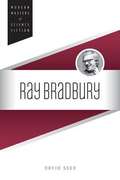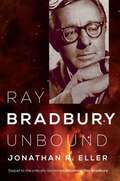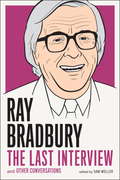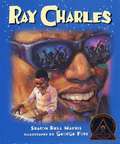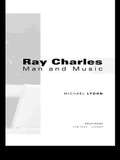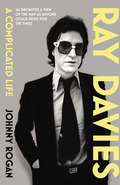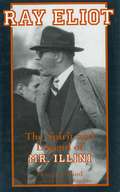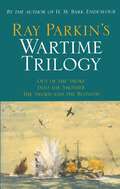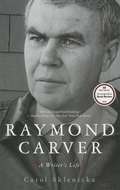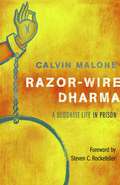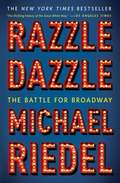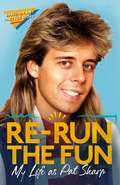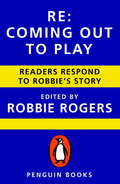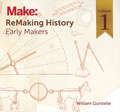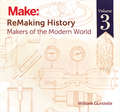- Table View
- List View
Ray Bradbury (Modern Masters of Science Fiction)
by David SeedAs much as any individual, Ray Bradbury brought science fiction's ideas into the mainstream. Yet he transcended the genre in both form and popularity, using its trappings to explore timely social concerns and the kaleidoscope of human experience while in the process becoming one of America's most beloved authors. David Seed follows Bradbury's long career from the early short story masterpieces through his work in a wide variety of broadcast and film genres to the influential cultural commentary he spread via essays, speeches, and interviews. Mining Bradbury's classics and hard-to-find archival, literary, and cultural materials, Seed analyzes how the author's views on technology, authoritarianism, and censorship affected his art; how his Midwest of dream and dread brought his work to life; and the ways film and television influenced his creative process and visually-oriented prose style. The result is a passionate statement on Bradbury's status as an essential literary writer deserving of a place in the cultural history of his time.
Ray Bradbury Unbound
by Jonathan R. EllerIn Ray Bradbury Unbound, Jonathan R. Eller continues the story begun in his acclaimed Becoming Ray Bradbury, following the beloved author's evolution from a short story master to a multi-media creative force and outspoken visionary. At the height of his powers as a poetic prose stylist, Bradbury shifted his creative attention to film and television, where new successes gave him an enduring platform as a compelling cultural commentator. His passionate advocacy validated the U.S. space program's mission, extending his pivotal role as a chronicler of human values in an age of technological wonders. Informed by many years of interviews with Bradbury as well as an unprecedented access to personal papers and private collections, Ray Bradbury Unbound provides the definitive portrait of how a legendary American author helped shape his times.
Ray Bradbury: The Last Interview
by Ray Bradbury Sam WellerRay Bradbury was one of our most influential sci-fi writers; the visionary author of the classic Fahrenheit 451 (Granada, 1954). But he also lived a fascinating life outside the parameters of sci-fi, and was a masterful raconteur of his own story, as he reveals in his wide-ranging, in-depth final interview with his acclaimed biographer Sam Weller. Bradbury constantly twists the elements of his life into a discussion of the influences and creative processes behind his literary form.
Ray Charles
by Sharon Bell Mathis George FordIn a beautiful new edition of this 1973 multiple award-winning biography, young readers learn the rags-to-riches story of legendary musician Ray Charles's life - from age 7, when he loses his sight completely, to age 40, when he performs to dazzled audiences world-wide and participates in the fight for racial justice. A new introduction by the author sets the context for Charles's journey to stardom, and an afterword updates his life to the present.<P><P>Winner of the Coretta Scott King Medal
Ray Charles
by Sharon Bell MathisCoretta Scott King Author Award Winner - American Library Association (ALA) Coretta Scott King Illustrator Award Winner - American Library Association (ALA)A beautiful new edition of the award-winning biography of world-famous musician Ray Charles.As a young boy he fell in love with music, and as a man, the world fell in love with his music. Ray Charles and his soulful, passionate rhythm and melodies have been embraced around the globe for decades. Now, in this beautiful new edition of the award-winning biography, readers can follow Charles from his boyhood, when he lost his sight completely and learned to read and write music in Braille, until the age of 40, when he had become a world-renowned jazz and blues musician. In a new introduction, the author updates Charles' life to the present day.
Ray Charles: Man And Music
by Michael LydonAn extremely detailed account of Ray Charles' personal life, from his childhood to his death and funeral, and of his musical life, including every concert, gig, recording etc.
Ray Charles: Man and Music, Updated Commemorative Edition
by Michael LydonRay Charles: Man and Music is a complete biography of this seminal singer/pianist who has been active on the American music scene since the mid-'50s. Originally published in 1995 by Penguin Books, and universally hailed as the definitive biography, this new edition will bring Charles's life up to date, covering the last 7 years of his life.There are only a few legendary singers who have developed mass audiences while pursuing their own artistic visions: Sinatra is one; Ella Fitzgerald another. Ray Charles undoubtedly belongs in this pantheon of major musical stars. Ray Charles: Man and Music begins with Charles's impoverished childhood in Greenville, Florida, where tragedy struck early when the young Charles went blind at age 6 and was orphaned at age 14. Driven by his enormous talent and determination, Charles landed work playing some of the toughest juke joints in the state, fought heroin addiction, and finally landed a recording contract with Atlantic Records. Unlike other R&B singers, Charles took control of his career from its earliest days, moving on from his gospel-soul stylings of the mid-'50s to break through musical barriers, recording two country albums in the late '50s (at a time when the black presence in country music was barely felt), pure jazz, and then the powerful pop hits of the '60s. Famed music journalist Michael Lydon - a founding editor of Rolling Stone - is uniquely qualified to document Charles's career, having interviewed Charles and followed the star's performances since the 1960s. Originally published in 1995, and universally hailed as the definitive biography, this new edition brings Charles's life up to date, covering the last 7 years of his life. It coincides with the release of a made-for-TV movie starring Jamie Fox as Charles, currently in production by Taylor Hackford. Charles has also issued a new CD recently and remains active as a touring artist throughout the world.
Ray Charles: Soul Man
by Ruth TurkA biography of the popular singer, who became blind as a young boy.
Ray Charles: Young Musician
by Susan SloateAs a child, Ray Charles learned not to give up when times were tough. In this inspiring narrative, young readers will learn how this groundbreaking musician overcame blindness in childhood to ascend the top ranks of American music in an era of deep racial segregation.
Ray Davies: A Complicated Life
by Johnny RoganNOW UPDATED WITH A NEW EPILOGUE In the summer of 1964, aged twenty, Ray Davies led the Kinks to fame with their number one hit ‘You Really Got Me’. Within months, they were established among the pop elite, swamped by fans and fast becoming renowned for the rioting at their gigs. But Ray’s journey from working-class Muswell Hill to the Rock ’n’ Roll Hall of Fame was tumultuous in the extreme, featuring breakdowns, bitter lawsuits, spectacular punch-ups and a ban from entering the USA. His relationship with his brother Dave is surely the most ferocious and abusive in music history. Based on countless interviews conducted over several decades, this richly detailed and revelatory biography presents the most frank and intimate portrait yet of Ray Davies.
Ray Eliot: The Spirit and Legend of Mr. Illini
by Doug CartlandThis biography of legendary University of Illinois coach Ray Eliot describes a man who loved football and motivating his team. Doug Cartland, writes of his grandfather's life as one to admire, to learn from, and to be inspired by.
Ray Milland: Identity, Stardom, and the Long Climb to The Lost Weekend
by Gillian KellyRay Milland (1907–1986) was the inaugural Welshman to win the Best Actor Academy Award, as well as a performer boasting a rich and varied oeuvre from the silent era in 1920s Britain to New Hollywood in the 1980s. Despite being one of the most prolific actors in cinema history who left behind a legacy of almost 180 film and television appearances across seven different decades, Milland remains a somewhat forgotten figure of cinematic history. Ray Milland: Identity, Stardom, and the Long Climb to “The Lost Weekend” fills this void in scholarship by offering a detailed examination of Milland as one of Hollywood’s most durable and fascinating performers of the studio era. The volume begins by exploring Milland’s unique Welsh identity in Hollywood, which was essentially erased by the studios. It then turns to his underexplored early career at MGM prior to signing with Paramount Pictures, where he remained for over two decades. Author Gillian Kelly discusses his early roles as a stereotypical “Brit” in Hollywood as well as his “stardom years” at Paramount where he often provided support for the studio’s leading ladies, including Claudette Colbert, Dorothy Lamour, and Paulette Goddard. A chapter is dedicated to his Oscar-winning performance in The Lost Weekend, and important later films like Dial M for Murder and Love Story also receive detailed analysis. Overall, Ray Milland provides a reappraisal of Milland’s earlier career and situates his performances within the broader tradition of star studies.
Ray Parkin's Wartime Trilogy
by Ray ParkinThese brilliant books hum with action, adventure and courage. Honestly and plainly written, they are full of humanity and great wisdom. Out of the Smoke tells of Ray's experiences as Action Chief Quartermaster in HMAS Perth, which was sunk while engaging an overwhelming Japanese naval force in the Sunda Strait. Two cruisers, HMAS Perth and USS Houston, fought until their ammunition was exhausted. Thus defenceless and surrounded, sunk by four torpedoes and gunfire. It had been a night action, desperate and determined until the inevitable end. A small party of the survivors tried to sail a derelict lifeboat to safety, only to land at a port in enemy hands. In his Introduction to the book, Sir Laurens van der Post describes Out of the Smoke as 'one of the great stories of war at sea'. Into the Smother tells, direct from the author's diary, of his fifteen months as a POW on the Burma-Siam {Thailand} railway. The construction of this railway remains one of history's most awful instances of man's inhumanity to man. Ray documents with remarkable restraint the horrors and sufferings he and his comrades endured at the mercy of the cruel jungle and the Imperial Japanese Army. The book has an appendix by Sir Edward 'Weary' Dunlop, to whose care Ray had entrusted his secret writings, drawings and paintings when taken to Japan. Into the Smother is impressive in its honesty and inspiring in its evocation of courage and endurance. The Sword and the Blossom tells of Ray's last twelve months of captivity. Shipped to Japan in an incredibly crowded, derelict tramp steamer, he and his comrades endured submarine attacks and weathered a typhoon with open hatches. They were then taken to a POW camp at Ohama, on the shores of Honshu, where they worked in a coal mine under the Inland Sea. With the dropping of the atomic bombs on Hiroshima and Nagasaki—one just to the north of them, the other just to the south-the POWs found themselves free among a people who had held over them the power of life and death. The Sword and the Blossom gives the reader a remarkable insight into the Japanese way of thinking, and lights the ghastly experience with magnificent prose. These classic books are illustrated with Ray Parkin's evocative and detailed drawings and sketches, made secretly at the time.
Raymond Carver: A Writer's Life
by Carol SklenickaThe first biography of america’s best-known short story writer of the late twentieth century.The London Times called Raymond Carver "the American Chekhov." The beloved, mischievous, but more modest short-story writer and poet thought of himself as "a lucky man" whose renunciation of alcohol allowed him to live "ten years longer than I or anyone expected." In that last decade, Carver became the leading figure in a resurgence of the short story. Readers embraced his precise, sad, often funny and poignant tales of ordinary people and their troubles: poverty, drunkenness, embittered marriages, difficulties brought on by neglect rather than intent. Since Carver died in 1988 at age fifty, his legacy has been mythologized by admirers and tainted by controversy over a zealous editor’s shaping of his first two story collections. Carol Sklenicka penetrates the myths and controversies. Her decade-long search of archives across the United States and her extensive interviews with Carver’s relatives, friends, and colleagues have enabled her to write the definitive story of the iconic literary figure. Laced with the voices of people who knew Carver intimately, her biography offers a fresh appreciation of his work and an unbiased, vivid portrait of the writer.
Razor-Wire Dharma
by Calvin Malone Sunyana Graef Steven C RockefellerCalvin Malone has plenty to teach us all about ideas that we rarely associate with the penal system: Dignity. Compassion. Freedom behind bars. He speaks from experience: Malone is nearing the end of a 20-year prison sentence himself.Razor-Wire Dharma is his eloquent, enlightening, and utterly inspiring personal story how he found Buddhism--and real, transformative meaning for his life-despite being in one of the world's harshest environments.Some of his stories are hilarious, some are harrowing, but all express Buddhist wisdom as vividly as any practitioner could hope to do. Malone is living it, and in the unlikeliest of places. For him, the choice of staying true to his principles often requires that he quite literally jeopardize his life, safety, and the few small comforts available to him to try to do what's right.Razor-Wire Dharma makes it clear that if Calvin can do what's right in jail, he can do it anywhere. What's more, it proves that we can, too.
Razzle Dazzle: The Battle for Broadway
by Michael Riedel&“A vivid page-turner&” (NPR) detailing the rise, fall, and redemption of Broadway—its stars, its biggest shows, its producers, and all the drama, intrigue, and power plays that happened behind the scenes.&“A rich, lovely, debut history of New York theater in the 1970s and eighties&” (Kirkus Reviews, starred review), Razzle Dazzle is a narrative account of the people and the money and the power that turned New York&’s gritty back alleys and sex-shops into the glitzy, dazzling Great White Way. In the mid-1970s Times Square was the seedy symbol of New York&’s economic decline. Its once shining star, the renowned Shubert Organization, was losing theaters to make way for parking lots and losing money. Bernard Jacobs and Jerry Schoenfeld, two ambitious board members, saw the crumbling company was ripe for takeover and staged a coup and staved off corporate intrigue, personal betrayals and criminal investigations. Once Jacobs and Schoenfeld solidified their power, they turned a collapsed theater-owning holding company into one of the most successful entertainment empires in the world, spearheading the revitalization of Broadway and the renewal of Times Square. &“For those interested in the business behind the greasepaint, at a riveting time in Broadway&’s and New York&’s history, this is the ticket&” (USA TODAY). Michael Riedel tells the stories of the Shubert Organization and the shows that re-built a city in grand style—including Cats, A Chorus Line, and Mamma Mia!—revealing the backstage drama that often rivaled what transpired onstage, exposing bitter rivalries, unlikely alliances, and inside gossip. &“The trouble with Razzle Dazzle is…you can&’t put the damn thing down&” (Huffington Post).
Re-run the Fun: My Life as Pat Sharp
by Pat Sharp Darren Richman Luke Catterson'The perfect antidote to 2020' Huffington Post'A must-read if you like funny things' Greg James'I had no idea Pat Sharp's life story would be so hilarious and I strongly suspect neither did he' Nish KumarPat Sharp is a man out of time.For those of a certain generation, he is an iconic figure synonymous with good fun, great hair and excess gunge. For others, he's just that bloke with a mullet. Fame is a fickle beast and, since the cancellation of Fun House in 1999 ('Just ten years into its run, when it was finally finding its feet'), Pat has become a reclusive figure, only emerging from his splendid isolation to pop up on things like I'm A Celebrity: Get Me Out Of Here, Never Mind the Buzzcocks and Come Dine with Me. Until now.With time on his hands and now reliant on a faulty memory, Pat has expertly blended fact and . . . fiction: revealing all about his adventures with David Hassselhoff at the Berlin Wall in 1989; how he broke up a fight between Damon Albarn and Liam Gallagher at a house party; the time he suggested Geri's dress be a Union Jack; and much more.A definitive work (based on very little fact) that anatomises the cultural trends of the '80s and '90s, Re-run the Fun is just the kind of sorta-biography we need in these turbulent times. Finally, the Great British public can learn what life is like just about in sight of the top - the highs, the lows and the hair tips.'It's easy to forget, as I had, that Pat Sharp is so much more than an iconic haircut and a helter-skelter - and this well overdue book goes into hilarious, largely-fabricated detail about Pat's critical role in shaping our world today' Rick Edwards'No previous knowledge of Pat Sharp is required' Paul Sinha
Re-run the Fun: My Life as Pat Sharp
by Pat Sharp Darren Richman Luke Catterson'The perfect antidote to 2020' Huffington Post'A must-read if you like funny things' Greg James'I had no idea Pat Sharp's life story would be so hilarious and I strongly suspect neither did he' Nish KumarPat Sharp is a man out of time.For those of a certain generation, he is an iconic figure synonymous with good fun, great hair and excess gunge. For others, he's just that bloke with a mullet. Fame is a fickle beast and, since the cancellation of Fun House in 1999 ('Just ten years into its run, when it was finally finding its feet'), Pat has become a reclusive figure, only emerging from his splendid isolation to pop up on things like I'm A Celebrity: Get Me Out Of Here, Never Mind the Buzzcocks and Come Dine with Me. Until now.With time on his hands and now reliant on a faulty memory, Pat has expertly blended fact and . . . fiction: revealing all about his adventures with David Hassselhoff at the Berlin Wall in 1989; how he broke up a fight between Damon Albarn and Liam Gallagher at a house party; the time he suggested Geri's dress be a Union Jack; and much more.A definitive work (based on very little fact) that anatomises the cultural trends of the '80s and '90s, Re-run the Fun is just the kind of sorta-biography we need in these turbulent times. Finally, the Great British public can learn what life is like just about in sight of the top - the highs, the lows and the hair tips.'It's easy to forget, as I had, that Pat Sharp is so much more than an iconic haircut and a helter-skelter - and this well overdue book goes into hilarious, largely-fabricated detail about Pat's critical role in shaping our world today' Rick Edwards'No previous knowledge of Pat Sharp is required' Paul Sinha
Re-run the Fun: My Life as Pat Sharp
by Pat Sharp Darren Richman Luke Catterson'The perfect antidote to 2020' Huffington Post'A must-read if you like funny things' Greg James'I had no idea Pat Sharp's life story would be so hilarious and I strongly suspect neither did he' Nish KumarPat Sharp is a man out of time.For those of a certain generation, he is an iconic figure synonymous with good fun, great hair and excess gunge. For others, he's just that bloke with a mullet. Fame is a fickle beast and, since the cancellation of Fun House in 1999 ('Just ten years into its run, when it was finally finding its feet'), Pat has become a reclusive figure, only emerging from his splendid isolation to pop up on things like I'm A Celebrity: Get Me Out Of Here, Never Mind the Buzzcocks and Come Dine with Me. Until now.With time on his hands and now reliant on a faulty memory, Pat has expertly blended fact and . . . fiction: revealing all about his adventures with David Hassselhoff at the Berlin Wall in 1989; how he broke up a fight between Damon Albarn and Liam Gallagher at a house party; the time he suggested Geri's dress be a Union Jack; and much more.A definitive work (based on very little fact) that anatomises the cultural trends of the '80s and '90s, Re-run the Fun is just the kind of sorta-biography we need in these turbulent times. Finally, the Great British public can learn what life is like just about in sight of the top - the highs, the lows and the hair tips.'It's easy to forget, as I had, that Pat Sharp is so much more than an iconic haircut and a helter-skelter - and this well overdue book goes into hilarious, largely-fabricated detail about Pat's critical role in shaping our world today' Rick Edwards'No previous knowledge of Pat Sharp is required' Paul Sinha
Re: Quin
by Robert BuckeyeThe influential, daring, and lacerating novels of Ann Quin were very much products of their time--but Quin herself had more than a little influence upon shaping the era in which she lived. Her works bracket the '60s and embrace their drive to experiment and break through to another form of consciousness, and so another means of telling stories, as J. G. Ballard, and B. S. Johnson were doing, and as, later--in many ways following directly in Quin's footsteps--Kathy Acker would as well. In reading Quin we are taught to question the very enterprise of fiction itself; to read Quin one must be prepared to lose one's way. Re: Quin is an unabashedly personal and partisan critical biography of one of the greatest and yet most neglected fiction writers of the so-called "experimental" wave of British novelists of the 1960s.
Re: Quin
by Robert BuckeyeThe influential, daring, and lacerating novels of Ann Quin were very much products of their time--but Quin herself had more than a little influence upon shaping the era in which she lived. Her works bracket the '60s and embrace their drive to experiment and break through to another form of consciousness, and so another means of telling stories, as J. G. Ballard, and B. S. Johnson were doing, and as, later--in many ways following directly in Quin's footsteps--Kathy Acker would as well. In reading Quin we are taught to question the very enterprise of fiction itself; to read Quin one must be prepared to lose one's way. Re: Quin is an unabashedly personal and partisan critical biography of one of the greatest and yet most neglected fiction writers of the so-called "experimental" wave of British novelists of the 1960s.
Re: Readers Respond to Robbie's Story
by Robbie RogersIn his memoir, Coming Out To Play, Robbie Rogers told the story of his incredible journey from terrified teenager to a trailblazing out and proud professional soccer player for the L.A. Galaxy. Since it was published, he has received letters from countless readers from all walks of life, all across the world, telling him how he has given them hope and that after reading his story, they felt compelled to share their own. RE: Coming Out To Play is a collection of ten of these stories. They show both the acceptance and love that so many receive as they come out, but also that there are many who still struggle with the fear that they will be rejected if they reveal the truth about themselves. This is why Rogers has collected these letters: to show those suffering in silence that they are not alone.
ReMaking History, Volume 1: Early Makers
by William GurstelleWilliam Gurstelle begins his remarkable journey through history with this volume, Early Makers. Each chapter examines a remarkable individual or group of people from the past whose insights and inventions helped create the world we live in. What sets this series apart from other history books - including other histories of technology - is that each chapter also includes step-by-step instructions for making your own version of the historical invention. History comes to life in a way you have never experienced before when you follow the inventors' steps and recreate the groundbreaking devices of the past with your own hands.In this volume you will discover:The Cave Dwellers of Lascaux and the Oil LampPythagoras and the Tantalus CupHeron and the Gin PoleEgypt's Bag PressOtto von Guerke and the Magdeburg HemispheresLevi ben Gershon and the Jacob's StaffJuliana Berners and the Fishing LureArchimedes and the Water ScrewChina's Differential WindlassBe sure to also check out ReMaking History, Volume 2: Industrial Revolutionaries and ReMaking History Volume 3:Makers of the Modern World.
ReMaking History, Volume 2: Industrial Revolutionaries
by William GurstelleIndustrial Revolutionaries is the second volume in William Gurstelle's unique exploration of history's great inventors. Each chapter revisits the life and times of one of the forward-thinking revolutionaries who helped create the world we live in. You will not only learn about their great inventions, you'll also get step-by-step instructions for recreating them yourself. History will come to life as you have never experienced it before when you build it with your own hands. Inside this volume, you will discover:Joseph McKibben and the Air MuscleSquire Whipple and the Iron BridgeAbe Lincoln and the Campaign TorchSamuel Morse and the TelegraphJ.F. Daniell and the Storage BatteryBen Franklin and the Leyden JarCharles Goodyear and the Vulcanization of RubberBe sure to also check out ReMaking History, Volume 1: Early Makers and ReMaking History, Volume 3: Makers of the Modern World.
ReMaking History, Volume 3: Makers of the Modern World
by William GurstelleMakers of the Modern World is the third volume of William Gurstelle's unique, hands-on journey through history. Each chapter examines a remarkable character from the past, one of the people whose insights and inventions helped create our modern world. What sets this series apart from other history books - including other histories of technology - is that each chapter also includes step-by-step instructions for making your own version of the historical invention. History comes to life in a way you have never experienced before when you follow the inventors' steps and recreate the groundbreaking devices of the past with your own hands.This volume brings you to the early modern era and the invention of the electric light, the movie projector, and the automobile. Inside, you will discover:Alessandro Volta and ElectroplatingHumphrey Davy and the First Electric lightGeorge Cayley and the Aeronautical GliderThe Lumiere Brothers and the Movie ProjectorRudolf Diesel and the Automobile EngineHans Goldschmidt and the Thermite ReactionAugust Mobius and the Mobius StripLouis Poinsot's Loads, Moments, and TorquesBe sure to also check out ReMaking History, Volume 1: Early Makers and ReMaking History Volume 2 :Industrial Revolutionaries.
